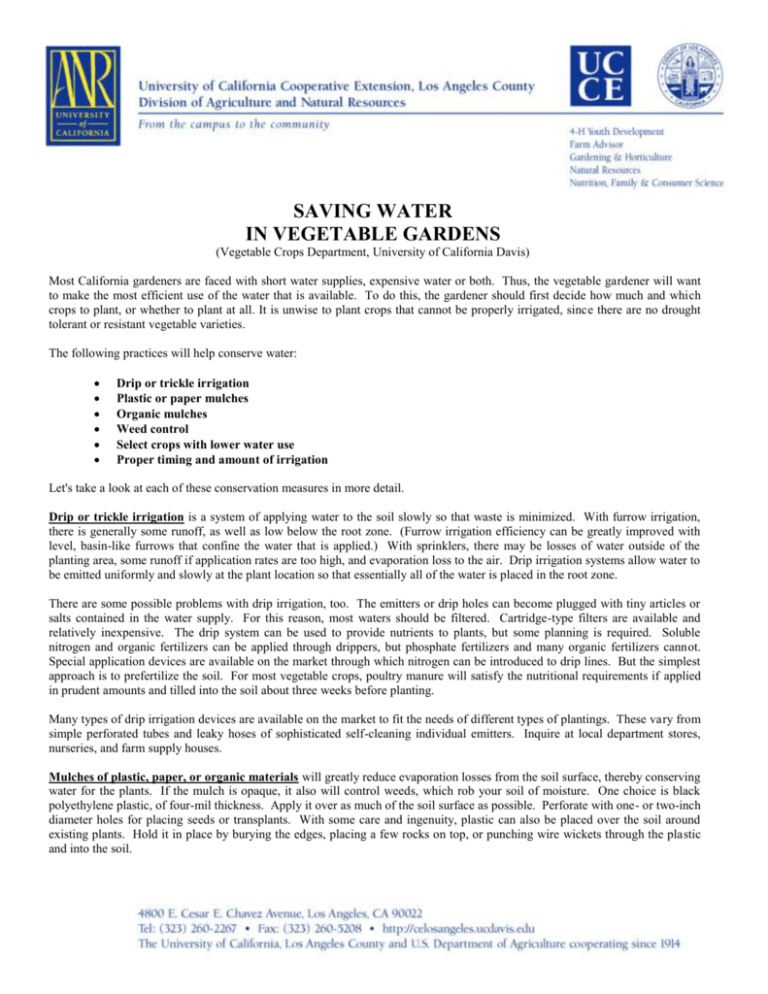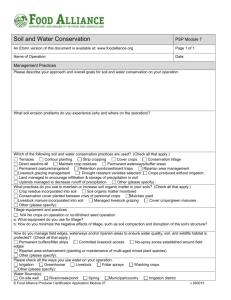English
advertisement

SAVING WATER IN VEGETABLE GARDENS (Vegetable Crops Department, University of California Davis) Most California gardeners are faced with short water supplies, expensive water or both. Thus, the vegetable gardener will want to make the most efficient use of the water that is available. To do this, the gardener should first decide how much and which crops to plant, or whether to plant at all. It is unwise to plant crops that cannot be properly irrigated, since there are no drought tolerant or resistant vegetable varieties. The following practices will help conserve water: Drip or trickle irrigation Plastic or paper mulches Organic mulches Weed control Select crops with lower water use Proper timing and amount of irrigation Let's take a look at each of these conservation measures in more detail. Drip or trickle irrigation is a system of applying water to the soil slowly so that waste is minimized. With furrow irrigation, there is generally some runoff, as well as low below the root zone. (Furrow irrigation efficiency can be greatly improved with level, basin-like furrows that confine the water that is applied.) With sprinklers, there may be losses of water outside of the planting area, some runoff if application rates are too high, and evaporation loss to the air. Drip irrigation systems allow water to be emitted uniformly and slowly at the plant location so that essentially all of the water is placed in the root zone. There are some possible problems with drip irrigation, too. The emitters or drip holes can become plugged with tiny articles or salts contained in the water supply. For this reason, most waters should be filtered. Cartridge-type filters are available and relatively inexpensive. The drip system can be used to provide nutrients to plants, but some planning is required. Soluble nitrogen and organic fertilizers can be applied through drippers, but phosphate fertilizers and many organic fertilizers cannot. Special application devices are available on the market through which nitrogen can be introduced to drip lines. But the simplest approach is to prefertilize the soil. For most vegetable crops, poultry manure will satisfy the nutritional requirements if applied in prudent amounts and tilled into the soil about three weeks before planting. Many types of drip irrigation devices are available on the market to fit the needs of different types of plantings. These vary from simple perforated tubes and leaky hoses of sophisticated self-cleaning individual emitters. Inquire at local department stores, nurseries, and farm supply houses. Mulches of plastic, paper, or organic materials will greatly reduce evaporation losses from the soil surface, thereby conserving water for the plants. If the mulch is opaque, it also will control weeds, which rob your soil of moisture. One choice is black polyethylene plastic, of four-mil thickness. Apply it over as much of the soil surface as possible. Perforate with one- or two-inch diameter holes for placing seeds or transplants. With some care and ingenuity, plastic can also be placed over the soil around existing plants. Hold it in place by burying the edges, placing a few rocks on top, or punching wire wickets through the plastic and into the soil. Clear plastic will increase soil temperature more than black plastic, but weeds will grow beneath it. Various types of paper will also prevent moisture loss from the soil surface. Heavy craft wrapping paper, insulating paper, and even newspaper can be used; they will deteriorate or break down more readily than plastic film. Organic mulches, which include shavings, compost, rice hulls, bark, straw, and similar materials reduce moisture loss. They should be placed in a layer that’s two or three inches thick to be the most effective. In addition to their value for moisture conservation, they can be tilled into the soil after cropping to improve the organic content. They will also be helpful in controlling weeds, if they are in a thick-enough layers. Organic mulches are not as efficient as plastic for moisture conservation, but they will be more attractive and perhaps more readily available. Weed control is essential to reduce competition between crops and weeds for soil moisture. It is best and easiest to remove weeds while the weeds are small. Keep the hoe sharp, and make shallow cuts to avoid brining deeper weed seeds to the surface. Pull weeds that are close to the garden plants. Crop selection is important where water is expected to be in short supply. Plants with shallow root systems will require more frequent irrigation to maintain a healthy growth rate. Shallow-rooted plants include potatoes, onions, most other bulb/root/tuber crops, celery, and cabbage family plants. Deep-rooted crops include tomatoes, corn, winter squash, sweet potatoes, melons, and asparagus. Beans, carrots, peppers, summer squash, and cucumbers are intermediate in root depth. Mulching, with either plastic or organic materials, will be more beneficial for the shallow-rooted crops by reducing surface evaporation. Also, be certain to plant crops at the time of year when they are best adapted, by growing coo-season crop during the cooler months and warmseason crops during spring through summer. See the list below for which crops are cool-season or warm-season. Proper timing and amount of irrigation will make the best use of available water. Irrigating "just to make sure" is wasteful. Letting the soil get too dry between irrigations is a waste of water, too, because it affects the ultimate yield and quality of the crop. Before deciding to irrigate, examine the soil at a depth of four to 12 inches. Squeeze it in your hand; if it holds t ogether without crumbling, moisture is probably adequate. Watch for slight wilting on hot afternoons. As the soil dries, the foliage will darken and take on a dull appearance. With some experience, these tests can help you develop an irrigation frequency plan that will make the most efficient use of your water. Where drip irrigation is to be used, the system should be operated frequently to maintain soil moisture and to prevent plugging of the small emission holes. As a general rule, turn the system on for about an hour every two to three days. Greater frequency for shorter periods daily will be required during hot weather for shallow-rooted crops. In summary: Don't plant more than can be irrigated properly with your available water. A combination of weed-free soil and a drip irrigation system under mulch will provide the most efficient system. COMMON WARM-SEASON AND COOL-SEASON VEGETABLE CROPS Warm-Season Vegetables Cool-Season Vegetables Cool-Season Vegetables Amaranthus Bean (all types) Cantaloupe Chayote Chinese Okra Corn, Sweet Cucumber Eggplant Jicama Muskmelon Okra Pepper (all types) Pumpkin Squash, Summer Squash, Winter Sweet Potato Tomatillo Tomato Watermelon Asparagus Artichoke Beets Bok Choy Broccoli Brussels Sprouts Cabbage Carrot Cauliflower Celery Chard Chinese Cabbage Chives Cilantro Collards Endive Garlic Horseradish Kale Kohlrabi Leek Lettuce Mustard Greens Onions Parsley Peas Potato Radish Rhubarb Rutabaga Shallots Spinach Turnip Watercress





